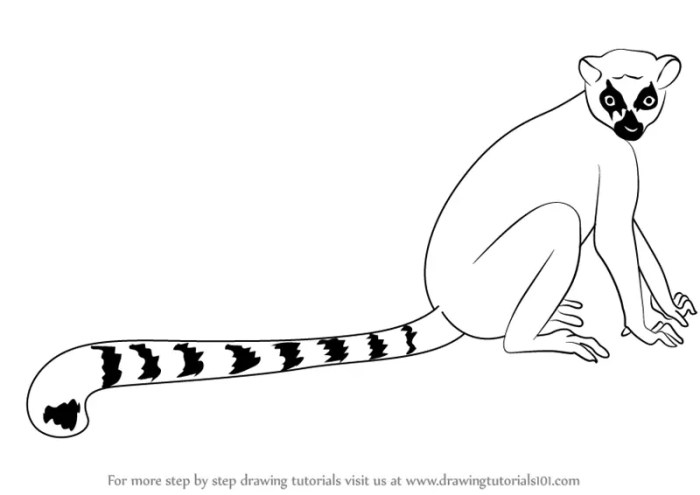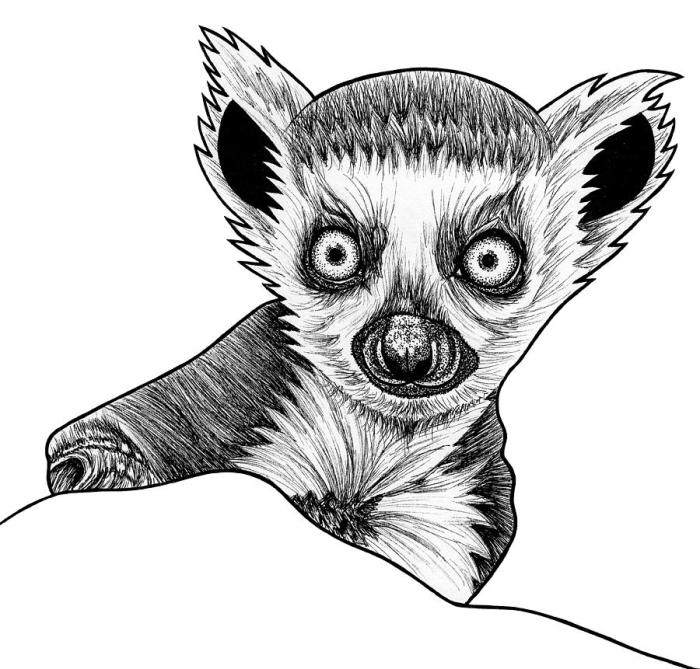Drawing Lemur Faces and Expressions

Easy drawing of lemurs – Drawing lemur faces, while seemingly simple, requires understanding their unique features to capture their distinct personalities. Accurate representation relies on observing the subtle variations in shape and proportion that differentiate species and expressions. This section will guide you through a step-by-step process for creating believable lemur faces, focusing on basic shapes and the nuances of emotional expression.
Step-by-Step Guide to Drawing a Lemur Face
Begin by sketching a basic circle for the head. This forms the foundation upon which all other features will be built. Next, add two slightly oval shapes for the eyes, positioned slightly below the center of the circle and separated by a space roughly equal to the width of one eye. These ovals should be slightly slanted, giving the eyes a characteristically expressive tilt.
Within each eye oval, draw a smaller, darker circle for the pupil. Lemurs often have large, expressive eyes, so ensure these are prominent. Below the eyes, add a small, rounded triangle for the nose. This should be relatively small compared to the eyes. Finally, draw a gently curved line for the mouth, positioning it below the nose.
The mouth’s curvature will determine the lemur’s expression, as detailed in the following section. Remember to add ears, typically rounded and positioned slightly above and behind the eyes. Refine the lines, adding details like fur texture and individual strands of hair around the face to complete the drawing.
Depicting Different Lemur Expressions
The expression of a lemur is primarily conveyed through the eyes and mouth. A happy lemur will typically have wide, slightly almond-shaped eyes and a gently upturned mouth. The pupils might be slightly smaller, reflecting a relaxed state. Conversely, a sad lemur will have narrowed eyes, often with slightly downturned corners, and a downturned mouth. The pupils may appear larger, giving a more melancholic look.
A curious lemur will have its eyes wide open, often with the pupils slightly dilated, conveying alertness and intrigue. The mouth might be slightly open, as if in anticipation or wonder. To achieve these expressions, subtly adjust the shapes and positions of the eyes and mouth, paying close attention to the curvature of the mouth line and the size and shape of the pupils.
Remember to also consider the positioning of the ears; slightly forward-pointing ears can add to a sense of alertness, while relaxed ears contribute to a more calm or content expression.
Comparison of Facial Features Across Lemur Species
The following table compares the facial features of different lemur species. Note that these are general observations, and individual variation exists within each species.
Drawing lemurs is surprisingly simple, focusing on their expressive eyes and fluffy tails. Adding a little flair? Learn how to easily create charming hats for your lemur drawings by checking out this helpful guide on how to draw a hat drawing easy. Once you’ve mastered basic hat shapes, you can add them to your lemurs for extra personality and create even more adorable artwork.
Experiment with different styles to see which complements your lemur’s unique charm!
| Lemur Species | Eye Shape and Size | Nose Shape and Size | Ear Shape and Size |
|---|---|---|---|
| Ring-tailed Lemur | Large, almond-shaped; relatively close-set | Small, rounded triangle | Rounded, medium-sized |
| Sifaka | Large, round; more widely spaced | Small, somewhat pointed | Rounded, relatively large |
| Indri | Large, round; widely spaced | Small, inconspicuous | Large, rounded, prominent |
| Mouse Lemur | Large, round; prominent | Small, pointed | Rounded, relatively small |
Adding Details to Lemur Drawings

Adding fine details elevates a lemur drawing from a simple sketch to a realistic and engaging piece of art. Careful attention to fur texture, color variations, and anatomical features like ears and tails significantly impacts the overall believability and aesthetic appeal of the artwork. This section explores techniques for achieving these details.
The process of adding detail involves a layered approach. Starting with basic shapes and proportions, as covered in previous sections, allows for a solid foundation upon which to build increasingly intricate details. Each subsequent layer of detail refines the image, creating depth and realism.
Fur Texture Techniques
Creating realistic fur texture in a lemur drawing requires a nuanced approach that goes beyond simply shading. Different techniques can be used depending on the desired level of detail and the medium employed.
- Hatching and Cross-Hatching: This classic drawing technique involves creating short, parallel lines (hatching) or intersecting lines (cross-hatch) to suggest the direction and density of fur. Varying the line weight and spacing creates a sense of depth and texture. For example, closely spaced, dark lines could depict dense fur on the lemur’s back, while lighter, more spaced lines could represent thinner fur on the belly.
- Stippling: This technique uses small dots to create texture. The density of dots determines the darkness and the overall texture. Closely packed dots create dark, dense fur, while sparsely placed dots suggest lighter, thinner fur. This is particularly effective for creating a soft, fluffy appearance.
- Scumbling: A dry-brush technique where paint or pastel is applied with a light touch, creating a broken, textured effect. This works well for depicting the slightly uneven texture of lemur fur.
- Blending: Softly blending different shades and tones of color can create a smooth, yet textured effect, especially useful for areas with shorter, finer fur.
Depicting Fur Colors and Patterns
Lemurs exhibit a remarkable diversity in fur color and patterns. Accurately representing these variations is crucial for creating a believable depiction.
- Color Layering: Begin with a base coat of the lemur’s primary fur color. Then, layer other colors on top to create depth and variation. For example, a ring-tailed lemur’s tail might start with a base coat of grey, then have darker grey layers added to create shadows and highlights.
- Gradients: Use smooth transitions between colors to create natural-looking variations in fur shading. This is particularly effective for depicting the subtle changes in color across a lemur’s body.
- Pattern Replication: Many lemurs have distinct patterns, such as stripes or spots. These can be created by carefully repeating shapes and colors across the lemur’s body. For instance, the black and white rings on a ring-tailed lemur’s tail require meticulous replication of the ring pattern along its length.
- Reference Images: Using high-quality photographs of lemurs as references is essential to ensure accuracy in color and pattern representation.
Drawing Lemur Ears and Tails, Easy drawing of lemurs
The ears and tails of lemurs are distinctive features that contribute significantly to their overall appearance. Accurate portrayal of these elements enhances the realism of the drawing.
- Ears: Start by sketching the basic shape of the ear, which is often large and rounded in lemurs. Add details such as the inner ear and subtle folds or creases in the skin. Consider the placement of the ear on the head – lemurs have relatively large ears in proportion to their heads. Shading is crucial for adding depth and form to the ears.
- Tails: The tail is another defining characteristic. Ring-tailed lemurs have long, bushy tails with distinctive rings, requiring careful attention to detail in replicating the pattern. Other lemurs may have shorter, bushier tails or long, thin tails. Begin by sketching the basic shape and length of the tail. Then, add details such as fur texture and shading to give it volume and realism.
Remember to consider the way the tail curves and moves naturally.
Query Resolution: Easy Drawing Of Lemurs
What type of pencils are best for drawing lemurs?
A variety of pencils can be used, from H pencils for light sketching to B pencils for darker shading. Experiment to find your preference.
How do I choose the right reference image?
Select clear, high-resolution images that showcase the lemur’s features clearly. Multiple angles are beneficial.
What if my lemur drawing looks too cartoonish?
Focus on accurate proportions and subtle shading to achieve a more realistic look. Pay close attention to anatomical details.
Are there any good online resources beyond this guide?
Many online tutorials and websites dedicated to animal drawing offer additional guidance and inspiration. Search for “animal drawing tutorials” or “primate anatomy for artists.”
